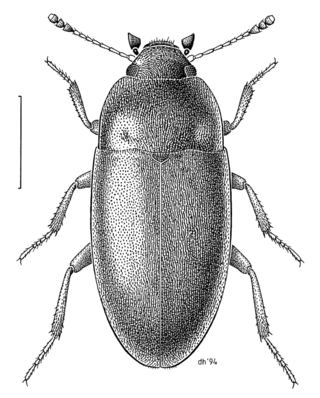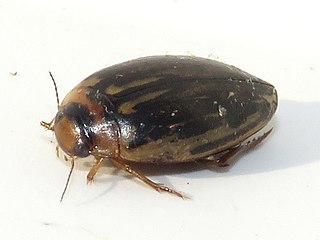
Amara is a large genus of carabid beetles, commonly called the sun beetles. Many are holarctic, but a few species are neotropical or occur in eastern Asia.

The family Archeocrypticidae is a small group of beetles with no vernacular common name, though recent authors have coined the name cryptic fungus beetles. Adults and larvae seems to be saprophagous and are often found in plant litter. Worldwide, about 10 genera and 50 species are found, most species are pantropical. Enneboeus caseyi has been recorded from the American South, Central America, and Mexico. About 20 species are found in Australia, in the genera Enneboeus,Australenneboeus and Gondwanenneboeus,Archeocrypticus,Falsoplatydema, Nothenneboeus, Sivacrypticus and Wattianus. They are largely absent from the Palearctic and Nearctic regions.

Amara aenea is a ground beetle common in almost the whole of Europe and Northern Asia. Its range covers also parts of Northern Africa. It is known as the common sun beetle.
Rhysodinae is a subfamily in the family Carabidae. There are 19 genera and at least 380 described species in Rhysodinae. The group of genera making up Rhysodinae had been treated as the family Rhysodidae in the past, and subsequent DNA analysis then placed it within Carabidae, where it was sometimes treated as the tribe Rhysodini, but the most recent analyses place it as a subfamily in a clade along with subfamilies Paussinae and Siagoninae, forming a sister to the remaining Carabidae.

Coptotomus is a genus of predaceous diving beetles in the family Dytiscidae, the only genus of the subfamily Coptotominae. There are about six described species in Coptotomus, found in North America and the Neotropics.

Hydrodytes is a genus of predaceous diving beetles in the family Dytiscidae. There are at least three described species in Hydrodytes. It is found in North America and the Neotropics.
Microhydrodytes is a genus of predaceous diving beetles in the family Dytiscidae. There is one described species in Microhydrodytes, M. elachistus. It is found in the Neotropics.
Copelatus ilybioides is a species of predaceous diving beetle in the family Dytiscidae. It is found in Africa.

Amara fulva is a species of ground beetle native to Europe.

Agabinae is a subfamily of predaceous diving beetles in the family Dytiscidae. There are about 11 genera and more than 460 described species in Agabinae.

Hydroporinae is a subfamily of predaceous diving beetles in the family Dytiscidae. There are at least 2,200 described species in Hydroporinae.

Colymbetini is a tribe of predaceous diving beetles in the family Dytiscidae. There are about 11 genera and more than 160 described species in Colymbetini.
Agabinus is a genus of predaceous diving beetles in the family Dytiscidae. There are at least two described species in Agabinus. They are found in North America.

Cybistrini is a tribe of predaceous diving beetles in the family Dytiscidae. There are 12 genera and 130 described extant species in Cybistrini. The same set is also called Cybistrinae by authors viewing it as a subfamily of Dytiscidae.
Hydroporus striola is a species of predaceous diving beetle in the family Dytiscidae. It is found in North America and the Palearctic.

Ilybius subaeneus is a species of predaceous diving beetle in the family Dytiscidae. It is found in North America and the Palearctic.

Hydrodytinae is a subfamily of predaceous diving beetles in the family Dytiscidae. There are at least two genera and four described species in Hydrodytinae.
Liadytiscinae is a subfamily of extinct predaceous diving beetles in the family Dytiscidae. There are about 5 genera and 10 described species in Liadytiscinae. All currently known members of the subfamily are known from the Early Cretaceous Jehol Biota of China.
Kakadudessus is a genus of predaceous diving beetles in the family Dytiscidae. There is one described species in Kakadudessus, K. tomweiri, found in Australasia.

Neobidessodes is a genus of predaceous diving beetles in the family Dytiscidae. There are about 10 described species in Neobidessodes. They are found in Australasia. The genus was first described in 2009, and the type species is N. denticulatus.










